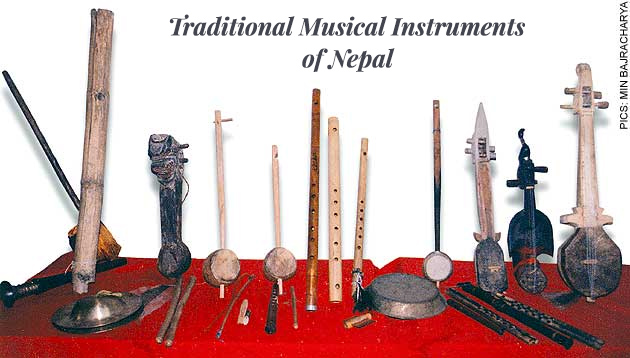Traditional Musical Instruments of Nepal

Nepal is a culturally rich landmark more than just a country. In this land area of 147,181 sq. Km there are numerous cultures and religions. Traditional musical instruments have always been the core to any cultural event in this cross-cultural nation. Different folk traditional musical instruments are played in different events like festivals, jatras, fairs and ceremonies and most of the musical instruments are folk musical instruments. These folk musical instruments are made from materials which are locally available. Sarangi, Jhyali, Madal are some of the examples of folk instruments in Nepal.
There are other numerous instruments that are also played in the ceremonies, Jatras and festivals in Nepal. These combination of folk musical instruments vary according to regions, relegions and races across the different cultures of Nepal.
Sarangi: Sarangi has always been famous among the Gandharvas of Nepal. It was introduced into existence by the Gandarva community from today’s Kaski District. Sarangi is made up of a single piece of wood from Khirro which is a special type of light wood. Lower part of the Sarangi is covered by dried skin of goat or sheep upon which the bridge is made to rest. Some Sarangi makers also use the skin of Komodo Dragon which keeps the tune of the Sarangi more stable. It has four string wires which was also traditionally made of dried intestines of goats and sheeps. It resembles to a violin.
Madal: Madal has always been one of the most popular folk music instrument in the Nepalese community. This was first introduced in the Magar Community of Nepal which accumulated popularity nationwide. It is basically made like drum which is made by making a hole through a thick log making it open on the both ends. The sides are then covered by goat or sheep skin and then played by hands. People carry it around their waist during the play.
Flute (Basuri/Murali): It is made out of small piece of thin hollow bamboo. Basuri/Murali is also one of the most popular folk musical instruments of Nepal. There are multiple holes carved in the bamboo stick on which fingers are placed. One of the holes at the end of the instrument is used to blow air into through which tunes are generated.
Jhyali/Jhyamta: Jhyamta/Jhyali are one of instruments used in the Panche Baja. It is a pair of two disc like musical instrument made of bronze or brass. The music generated from this instrument is the outcome of beating these two at eachother.
Nagara/Damaha: This is also another instrument which is the part of the Panche Baja. This instrument is made covering a hollow copper bowl shaped instrument with stretched leather. This traditional musical instrument is played by hitting it with sticks or hands.
Tyamko: It also is the part of the traditional Panche Baja. It is very close in look like Damaha. However it is smaller in size and produces different sound than Damaha. It is also played with sticks called Gajo.
Sanai: It is also one of the constituents of Panche Baja. It is a type clarinet and made of a metal pipe which is bent towards the front with a couple of holes. The hole on the top is used to blow into.
Narshingha: It is one of the 5 instruments of Panche Baja. It is a two piece detachable copper tube in a curved shape. It is played by blowing air into it through the mouth piece.
Tungna: It one also one of the most popular traditional musical instruments that comes from the culture in the Mountains. It is made from a single wood mainly from Rhododendron. It works with the similar principle of a guitar. It lacks frets and has only four strings similar to that of Sarangi.
These are only a few of the wide range of folk musical instruments that are seen in the multi-ethnic cultures of Nepal. There is a whole different array of musical instruments played by Newars, Gurungs, Magars and Kirats which have not been included in this blog. All these folk musical instruments have played a very significant role is preserving these cultures and rituals since centuries. Including all the musical instruments in detail would require for us to draft a bulky encyclopedia. However if you want to really know these cultures and the musical instruments, there wouldn’t be a better way than visiting these cultures yourselves during your visit to Nepal.

